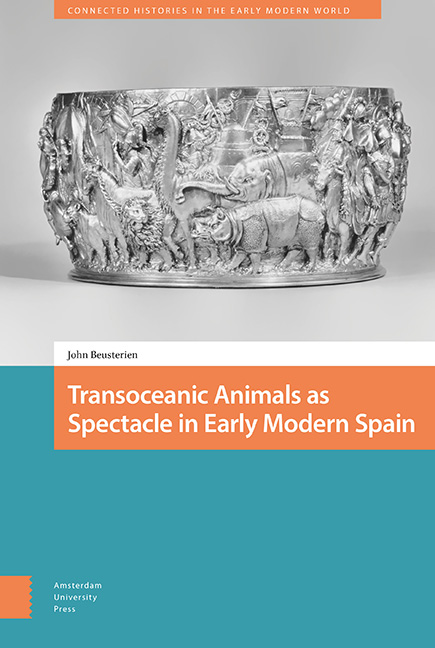Book contents
- Frontmatter
- Dedication
- Contents
- List of Illustrations
- Prologue
- Introduction: Armored Beasts and the Elephant in the Room
- 1 Hawa’i the Elephant and Abada the Rhinoceros
- 2 Fuleco the Armadillo
- 3 Jarama the Bull and Maghreb the Lion
- Conclusion: Biogeography as a Teaching Tool
- Appendix 1 Biogeography Course Project: Naming an Early Modern Animal
- Appendix 2 Bibliography for the Study of Animals and Early Modern Spain
- Index
1 - Hawa’i the Elephant and Abada the Rhinoceros
Published online by Cambridge University Press: 21 November 2020
- Frontmatter
- Dedication
- Contents
- List of Illustrations
- Prologue
- Introduction: Armored Beasts and the Elephant in the Room
- 1 Hawa’i the Elephant and Abada the Rhinoceros
- 2 Fuleco the Armadillo
- 3 Jarama the Bull and Maghreb the Lion
- Conclusion: Biogeography as a Teaching Tool
- Appendix 1 Biogeography Course Project: Naming an Early Modern Animal
- Appendix 2 Bibliography for the Study of Animals and Early Modern Spain
- Index
Summary
Abstract
Chapter 1 provides a biogeography of Hawa’i the elephant and Abada the rhinoceros, beginning with their births in India. When Philip II came into the possession of both animals, he took advantage of the financial and structural relationship between hospitals and theaters and placed each animal in a hospital in Madrid, where the public was charged a fee to see them. The spectacle of Abada and Hawa’i functioned like a proto-zoo, reflecting the emerging public sphere and Philip II's desire to enhance the image of the capital city. Chapter 1 also examines a silver-gilt ewer (1583) designed by Juan de Arfe that uses an image of Abada and Hawa’i to show off Philip II's planetary power.
Keywords: zoo history, public sphere, Philip II of Spain (1527–98), Hawa’i the elephant (ca. 1580–ca. 1593), Abada the rhinoceros (1573–91), Juan de Arfe y Villafane (1535–1603)
The zoo is a microcosm of the Anthropocene because it is a space where humans determine animal reproduction and choose who belongs. Madrid constructed a zoo in the Casa de Campo in 1972 and, before that, in the eighteenth century, the public went to see lions in cages in the Buen Retiro Park. Even before the creation of the Casa de Campo zoo and Buen Retiro Park, people had already visited a proto-zoo, where they paid a fee to see an elephant and a rhinoceros in Madrid.
The following chapter follows the material conditions of the lives of the elephant Hawa’i and the rhinoceros Abada, especially focusing on their use as public spectacle in two hospitals in Madrid from 1583 to 1591. The chapter explains the nature of spectatorship for the sixteenth-century viewing public. People that saw Hawa’i and Abada saw different things. Like seeing a play, experiencing Hawa’i and Abada constituted complex social thinking and affective reactions based on the audience's sense of collectivity and individuality.
In general, the display of Hawa’i and Abada set destructive precedents for the lives of animals more generally because it perpetuated the elite gifting of live animals in a global economy, fomented an emerging orientalism, made the rhino body a symbol of a panacea, and used animals to create a sense of the world in which they were captive enemies of a universal monarchy.
- Type
- Chapter
- Information
- Transoceanic Animals as Spectacle in Early Modern Spain , pp. 35 - 114Publisher: Amsterdam University PressPrint publication year: 2020



